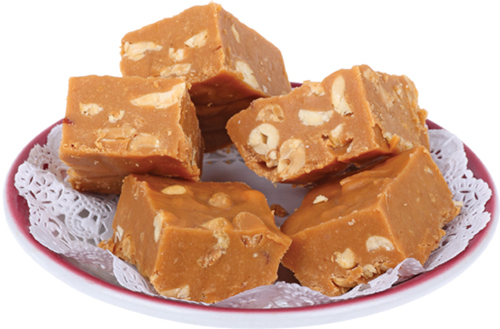
All categories of candy—from red-and-white striped peppermint canes to seductive and luscious chocolate truffles—are part of most collections of Christmas treats. But for those who are gluten-intolerant, commercially made versions of these candies are off limits because of the possibility of contamination in the factory.
The recipes in this chapter are all open to personal interpretation, another reason for making treats in your own kitchen. They include decadently rich chocolate truffles, different types of fudge, and variations on nougat—another classic holiday treat.
The best way to include candies as part of your holiday treat collection is to put the morsels into small paper cups, and do keep the pieces small! They’re very rich, and a one-inch cube is about the right size.
Although all the confections in this chapter are unbaked, many of them call for toasting nuts in the oven. The alternative method is to toast them in a dry skillet over medium heat, stirring often.

Most candy recipes instruct you to boil your sugar mixture until it reaches a certain temperature. The final texture of candy depends on the sugar concentration. As the syrup is heated, it boils, water evaporates, the sugar concentration increases, and the boiling point rises. A given temperature corresponds to a particular sugar concentration. In general, higher temperatures and greater sugar concentrations result in hard, brittle candies, and lower temperatures result in softer candies.
For the best results and most accuracy, use a candy thermometer. However, if you don’t have one, there is a classic test conducted by dropping a few droplets of the boiling syrup into ice water and then feeling the result. If you want to practice this, bring some sugar syrup to a boil, and then test it every few minutes to feel the result. Here are the stages of sugar:
• Thread stage: 230 to 233°F, with sugar concentration at 80 percent. This is used for the sorts of syrup you’d use on ice cream. At this temperature the liquid forms threads but does not form a ball.
• Soft ball stage: 234 to 240°F, with sugar concentration at 85 percent. This is the temperature used for fudge and other soft candies. Sugar syrup dropped into cold water will form a soft, flexible ball. If you remove the ball from water, it will flatten like a pancake after a few moments in your hand.
• Firm ball stage: 244 to 248°F, with sugar concentration at 87 percent. This is the temperature used for caramel candies and other candies with medium density. Drop a little of this syrup in cold water and it will form a firm ball, one that won’t flatten when you take it out of the water but remains malleable and will flatten when squeezed.
• Hard ball stage: 250 to 266°F, with sugar concentration at 92 percent. This is the temperature for nougat and other chewy and dense candy. A little of this syrup dropped into cold water will form a hard ball. If you take the ball out of the water, it won’t flatten. The ball will be hard, but you can still change its shape by squashing it.
• Soft crack stage: 270 to 290°F, with sugar concentration at 95 percent. Saltwater taffy is made with sugar at this temperature. As the syrup reaches soft-crack stage, the bubbles on top will become smaller, thicker, and closer together. At this stage, the moisture content is low. When you drop a bit of this syrup into cold water, it will solidify into threads that, when removed from the water, are flexible, not brittle. They will bend slightly before breaking.
• Hard crack stage: 295 to 310°F with a sugar concentration of 99 percent. This temperature is needed for brittles and butter toffee. The hard-crack stage is the highest temperature you are likely to see specified in a candy recipe. At these temperatures, there is almost no water left in the syrup. Drop a little of the molten syrup in cold water and it will form hard, brittle threads that break when bent.
• Caramelized sugar: 320 to 340°F, with a sugar concentration of 100 percent. At the lower end of this range the liquid is clear, and as it climbs in temperature, it turns to a golden and then deeper brown. This is what is used to make caramel sauce, not caramel candies.
Note: The temperatures specified here are for sea level. At higher altitudes, subtract 1°F from every listed temperature for each 500 feet above sea level.
As you can see, a few degrees in one direction or another can change the results of the candy, so it’s a good idea to test your thermometer’s accuracy by placing it in plain boiling water. At sea level, it should read 212°F. If it reads above or below this number, make the necessary adjustments when cooking your sugar syrup.